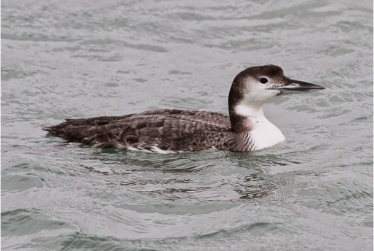Scientific Name: Gavin immer
Bird Name: Divers also known as Loons in Canada and North America.
On amber list for for Birds of Conservation Concern. It is one of three species of Divers( Loons) found in Ireland. It is the National Bird of Canada where it is known as the Common Loon.
This diver is a winter visitor and eats fish and crustaceans. They arrive in August and move back to their breeding grounds of North America, Greenland and Iceland in April and May. Some do stay in Ireland during the Summer but do not breed here.Fishermen thought they could not fly.
They weigh 3.6 to 4.5kg as bones are dense unlike most birds who have honeycomb bones to help them fly. Spends months on the sea without coming to land. They sleep in the water , to sleep it turns it’s neck and folds it’s head down to rest on it’s back. They take short naps 15minutes on average.
It’s feet are placed more to the tail of the bird which makes walking very difficult however makes them great divers.They sometimes have to lie on their stomach and push themselves along with their feet when on land. They have red eyes which gives them great vision underwater.They have a spear like horizontal bill and have a nostril valve which closes when submerged .

Great Northern Diver




No Comments
Add a comment about this page